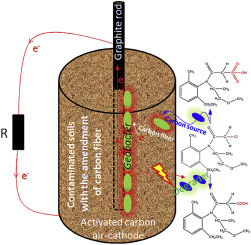当前位置:
X-MOL 学术
›
Chemosphere
›
论文详情
Our official English website, www.x-mol.net, welcomes your feedback! (Note: you will need to create a separate account there.)
The metolachlor degradation kinetics and bacterial community evolution in the soil bioelectrochemical remediation.
Chemosphere ( IF 8.8 ) Pub Date : 2020-01-13 , DOI: 10.1016/j.chemosphere.2020.125915 Xiaojing Li 1 , Yue Li 1 , Xiaolin Zhang 1 , Xiaodong Zhao 2 , Xiaodong Chen 1 , Yongtao Li 3
Chemosphere ( IF 8.8 ) Pub Date : 2020-01-13 , DOI: 10.1016/j.chemosphere.2020.125915 Xiaojing Li 1 , Yue Li 1 , Xiaolin Zhang 1 , Xiaodong Zhao 2 , Xiaodong Chen 1 , Yongtao Li 3
Affiliation

|
Herbicide-polluted soils have posed a threat to the crop growth and agro-product quality and safety. Even worse, the low-content of residue is still appreciable for a long time in subsurface soils. The soil bioelectrochemical remediation system (BERS) provides an inexhaustible electron acceptor to cause in situ indigenous microorganisms to generate biocurrent and accelerate the removal of metolachlor (ML). As a result of carbon fiber amendment, the highest current density (637 ± 19 mA/m2) to date has been generated in a soil BERS. The ML half-life and complete removal time decreased from 21 to 3 d and from 245 to 109 d, respectively. Importantly, the soil BERS was verified to be an effective treatment method for low-polluted sediments/soils, whether by ML or by its degradates. The quantitative degradates of ML showed that the first step was dechlorination based on the bioelectrochemical degradation pathway. The biocurrent selectively enriched special species, e.g., Geobacter and Thermincola for bioelectricity generation and Ralstonia, Phyllobacterium and Stenotrophomonas for degradation in soils. Meanwhile, Flavisolibacter and Gemmatimonas occupied the core niche in strengthening interspecific relationships by the biocurrent. This study firstly revealed the explicit abundance of Geobacter in agricultural soils and laid a foundation for the function design of mixed bacteria in the sediment/soil BERS.
中文翻译:

土壤生物电化学修复中的异丙甲草胺降解动力学和细菌群落进化。
受除草剂污染的土壤对作物的生长以及农产品的质量和安全构成了威胁。更糟糕的是,在地下土壤中,残留物的低含量仍会持续很长时间。土壤生物电化学修复系统(BERS)提供了一个取之不尽的电子受体,可以使原位本地微生物产生生物电流并加快对甲草胺(ML)的去除。碳纤维改良的结果是,土壤BERS产生了迄今为止最高的电流密度(637±19 mA / m2)。ML的半衰期和完全清除时间分别从21减少到3 d和从245减少到109 d。重要的是,无论是通过ML还是通过其降解,土壤BERS都被证明是一种有效的低污染沉积物/土壤处理方法。ML的定量降解表明,第一步是基于生物电化学降解途径的脱氯。生物电流选择性地富集了特殊物种,例如,用于生物发电的Geobacter和Thermincola以及用于在土壤中降解的Ralstonia,Phyllobacterium和Stenotrophomonas。同时,黄杆菌和芽孢杆菌在通过生物电流加强种间关系方面占据了核心位置。本研究首先揭示了土壤中土壤杆菌的明显丰富,为沉积物/土壤BERS中混合细菌的功能设计奠定了基础。毛状杆菌和嗜单胞菌可在土壤中降解。同时,黄杆菌和芽孢杆菌在通过生物电流加强种间关系方面占据了核心位置。本研究首先揭示了土壤中土壤杆菌的明显丰富,为沉积物/土壤BERS中混合细菌的功能设计奠定了基础。毛状杆菌和嗜单胞菌可在土壤中降解。同时,黄杆菌和芽孢杆菌在通过生物电流加强种间关系方面占据了核心位置。该研究首先揭示了土壤中土壤杆菌的明显丰富,为沉积物/土壤BERS中混合细菌的功能设计奠定了基础。
更新日期:2020-01-14
中文翻译:

土壤生物电化学修复中的异丙甲草胺降解动力学和细菌群落进化。
受除草剂污染的土壤对作物的生长以及农产品的质量和安全构成了威胁。更糟糕的是,在地下土壤中,残留物的低含量仍会持续很长时间。土壤生物电化学修复系统(BERS)提供了一个取之不尽的电子受体,可以使原位本地微生物产生生物电流并加快对甲草胺(ML)的去除。碳纤维改良的结果是,土壤BERS产生了迄今为止最高的电流密度(637±19 mA / m2)。ML的半衰期和完全清除时间分别从21减少到3 d和从245减少到109 d。重要的是,无论是通过ML还是通过其降解,土壤BERS都被证明是一种有效的低污染沉积物/土壤处理方法。ML的定量降解表明,第一步是基于生物电化学降解途径的脱氯。生物电流选择性地富集了特殊物种,例如,用于生物发电的Geobacter和Thermincola以及用于在土壤中降解的Ralstonia,Phyllobacterium和Stenotrophomonas。同时,黄杆菌和芽孢杆菌在通过生物电流加强种间关系方面占据了核心位置。本研究首先揭示了土壤中土壤杆菌的明显丰富,为沉积物/土壤BERS中混合细菌的功能设计奠定了基础。毛状杆菌和嗜单胞菌可在土壤中降解。同时,黄杆菌和芽孢杆菌在通过生物电流加强种间关系方面占据了核心位置。本研究首先揭示了土壤中土壤杆菌的明显丰富,为沉积物/土壤BERS中混合细菌的功能设计奠定了基础。毛状杆菌和嗜单胞菌可在土壤中降解。同时,黄杆菌和芽孢杆菌在通过生物电流加强种间关系方面占据了核心位置。该研究首先揭示了土壤中土壤杆菌的明显丰富,为沉积物/土壤BERS中混合细菌的功能设计奠定了基础。



























 京公网安备 11010802027423号
京公网安备 11010802027423号